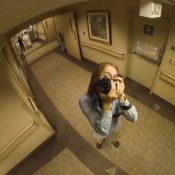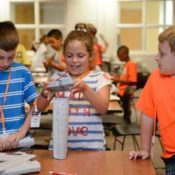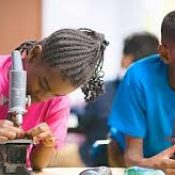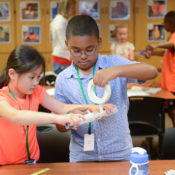
The BOOST Breakfast Club Blog is a curated space where bloggers from around the world contribute content on a continual basis about a variety of topics relevant to in and out-of-school time. The BOOST Breakfast Club blog is at the heart of an ongoing dialogue where expanded learning and education professionals share their personal thoughts and stories from the in and out-of-school time field. They also tell us what they ate for breakfast!
The BOOST Breakfast Club Blog is Brain Food for In and Out-of-School Time Leaders!
Interested in becoming a blogger? Email breakfastclub@boostcollaborative.org
Click here to Register for a free account or click here to Login to your existing account.
Author: Eric Iversen
Bringing at-home STEM success into focus
STEM has left the building For a long time, advocates of STEM education have worked to bring STEM learning closer to students’ lives outside of school. This year, though, COVID has made STEM learning a part of students’ lives outside of school in ways nobody ever imagined or wanted. The pandemic has forcibly ejected STEM from the traditional in-building school environment and strewn it about in a ...
At-home Learning in Crisis Times (with the Cat in the Hat)
Largely at a loss Nobody has any very good answers amid the anxiety and trauma of these COVID-19 times. But efforts to help, share, and encourage each other have overflowed in online education communities, to the benefit of educators, students, and families. Floods of ideas and resources have come from countless individuals and organizations to help the millions of families whose households have s...
How To Bring A Student’s “Security Mindset” Into Focus
A certain theory holds that people who succeed in cybersecurity, like the rich, are different from you and me. They see things from a different slant, finding patterns and connections in seemingly mundane or familiar environments that other people cannot see. Security guru Bruce Schneier describes it this way: “Security requires a particular mindset. Security professionals – at least the goo...
In Spring Time, Kids’ Thoughts Turn to … Cybersecurity Summer Camp?
It’s not quite as big as Opening Day for Major League Baseball, but early spring is the time for one of the biggest events in cybersecurity summer camp season: The opening of registration for GenCyber camps, free education and awareness camps in cybersecurity for K-12 students and teachers. The National Science Foundation and the National Security Agency jointly run the GenCyber program, which fe...
How to Start the Afterschool Engineering Club You’ve Always Wanted
For all the popularity of STEM activities outside of school time, engineering remains something of a neglected stepchild. “Full STEM Ahead,” an America After 3 PM survey, found that the favored siblings in the STEM family, science and math, feature in a preponderance of available programs, 60 and 45 percent, respectively. Technology and engineering share the table scraps, named in less than a thir...
Books to Help Build Elementary Students’ Understanding of Engineering
Thoughts Turn In Springtime … For the last several weeks, the view from my office on the third floor has been of treetops filling out with leaves. Looking down to the ground, I can see flowers coming into bloom, bushes becoming green, and animals of all kinds scurrying, hopping, or flying about, urgently concerned with their appointed, springtime tasks. It’s a delight and a wonder to see the natur...
Cybersecurity Taking Root in Afterschool
The best and worst of online times. What do you know about Cybersecurity? The Internet, as we all know, offers all the information you could ever want to find, all the time, from anywhere. Unfortunately, “all the information” includes a lot of revealing, specific data about ourselves, our property, and things we care about that we might not want or even understand to be available. Staying protecte...
STEM Ready America Report Shows Off Afterschool STEM Learning
The story of the year in afterschool STEM learning just might have come out this week in Washington, DC. At the National Press Club, people from all corners of the afterschool STEM world gathered to learn about STEM Ready America, a new report on afterschool STEM that effectively defines the national paradigm for activities in the field. Program leaders and policy thinkers, corporate and non-profi...
Arab Women Make a Charge into Engineering
In the face of strong headwinds… In Saudi Arabia, women can’t drive. In Lebanon, sexual harassment is legal. And even in the United Arab Emirates – relatively advanced on gender issues among predominantly Muslim countries – men can physically discipline their wives. Across all 22 states in the Arab world, women face legal and cultural obstacles unfamiliar to women in the United States. Arab Women ...
It’s (Out-of-School) Time for Engineering
In at least two ways, out-of-school programs are little different from their school-day counterparts. For one, STEM education is popular and widely available. Nearly 70 percent of out-of-school programs offer some kind of STEM content. For another, engineering, the “E” in STEM, is the least developed part of the picture. As with K-12 schools, out-of-school programs focus far more on sc...













